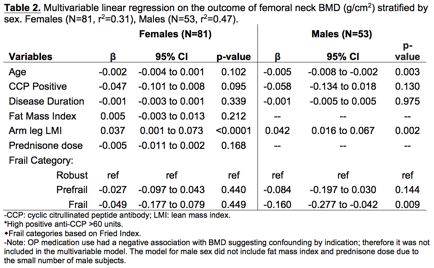Session Information
Date: Tuesday, October 23, 2018
Title: Osteoporosis and Metabolic Bone Disease – Basic and Clinical Science Poster
Session Type: ACR Poster Session C
Session Time: 9:00AM-11:00AM
Background/Purpose: Frailty in the general population is associated with poor outcomes including osteoporosis (OP), fracture and death. Frailty occurs at a higher rate in RA than in the general population. It is not known, however, if frailty is associated with lower bone mineral density (BMD) in RA. We investigated associations between frailty, RA clinical characteristics, medication use, and body composition and BMD in patients with RA.
Methods: We performed a cross-sectional analysis of a longitudinal RA cohort study from years 2007-2009. All patients met ACR classification criteria for RA. Frailty was evaluated using the Fried Index, categorizing each participant as robust, pre-frail or frail. We used linear regression to evaluate the association between predictors and femoral neck BMD. To identify independent predictors of BMD, we performed a multivariable linear regression analysis that included variables significant in the univariable analyses at p<0.10. Because sex differences in frailty were noted, we performed additional sex-stratified multivariable analyses.
Results: There were 138 participants (82 females, 56 males) and the mean age was 58.0±10.8 years. 70% were rheumatoid factor positive, and 55% were high anti-cyclic citrullinated peptide (CCP) positive (>60 units). Mean disease duration was 19±10.9 years. 52% had low BMD based on a T or Z score £-1.0. 44% of participants reported taking prednisone and 27% reported taking OP medications. Males had higher rates of frailty (11% robust, 63% prefrail, 27% frail) compared to females (22% robust, 72% prefrail and 6% frail). In the entire cohort, age, high positive anti-CCP and frailty had independent negative associations with BMD (β=-0.003, -0.052 and -0.093 respectively, p<0.05) (Table 1). Appendicular lean mass index (ALMI) had a positive linear association with BMD (β=0.042, p<0.0001). In females, only ALMI had a significant independent association with BMD (β=0.037, p<0.0001). In males, frailty carried the strongest independent association with BMD (β=-0.160, p<0.01). Age and ALMI also maintained their independent associations with BMD in males (β=-0.005 and 0.042 respectively, p<0.01).
Conclusion: Frailty, high positive anti-CCP, ALMI and age were independently associated with BMD in patients with RA. Males had higher rates of frailty than females, and in sex-stratified analysis, frailty was independently associated with BMD in males but not in females. Our findings suggest that frailty is an important factor associated with low BMD and that sex may influence the development of frailty in patients with RA.
To cite this abstract in AMA style:
Wysham KD, Shoback DM, Imboden JB Jr., Katz P. Sex Differences in the Association of Frailty and Bone Mineral Density in Patients with Rheumatoid Arthritis [abstract]. Arthritis Rheumatol. 2018; 70 (suppl 9). https://acrabstracts.org/abstract/sex-differences-in-the-association-of-frailty-and-bone-mineral-density-in-patients-with-rheumatoid-arthritis/. Accessed .« Back to 2018 ACR/ARHP Annual Meeting
ACR Meeting Abstracts - https://acrabstracts.org/abstract/sex-differences-in-the-association-of-frailty-and-bone-mineral-density-in-patients-with-rheumatoid-arthritis/


